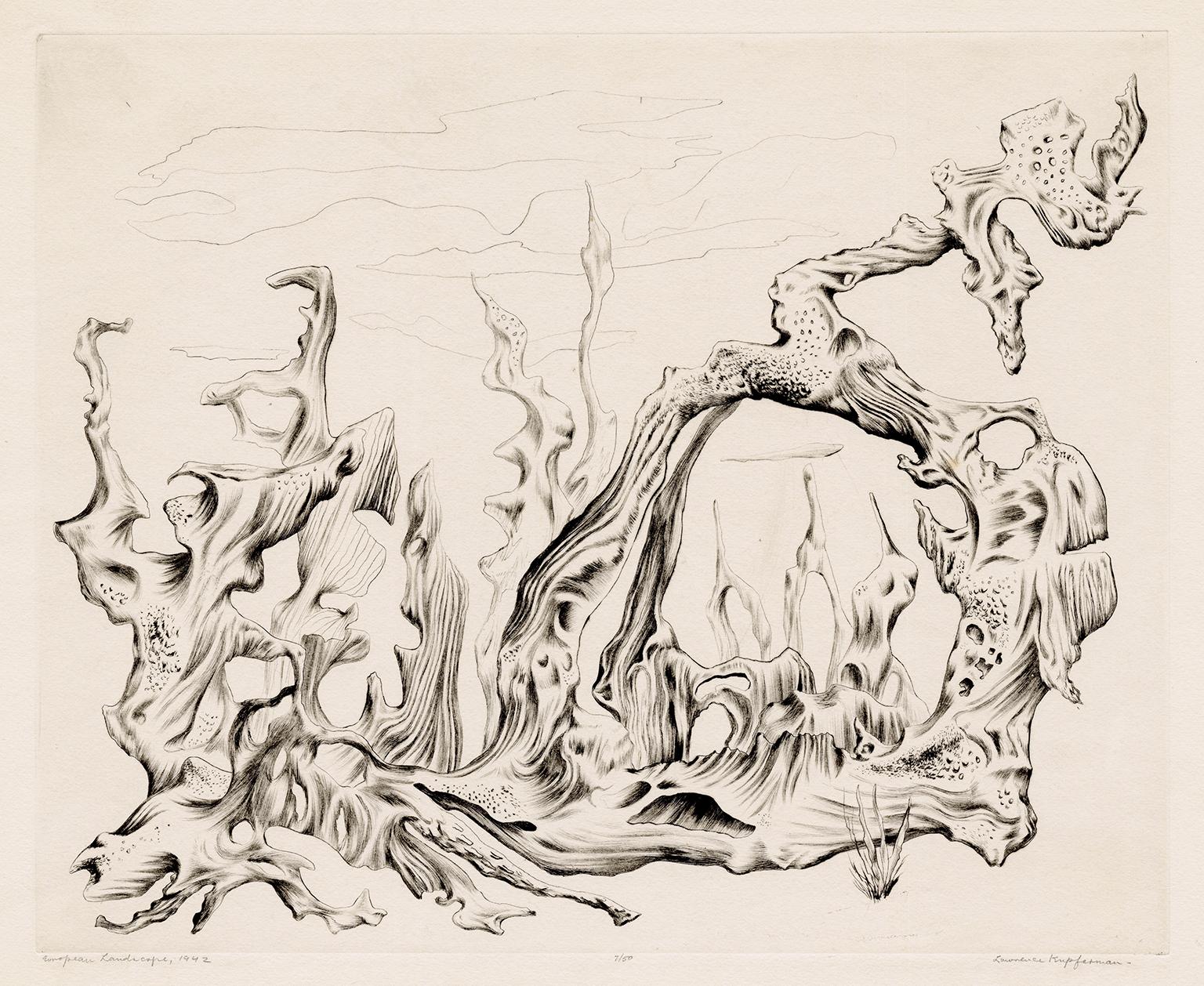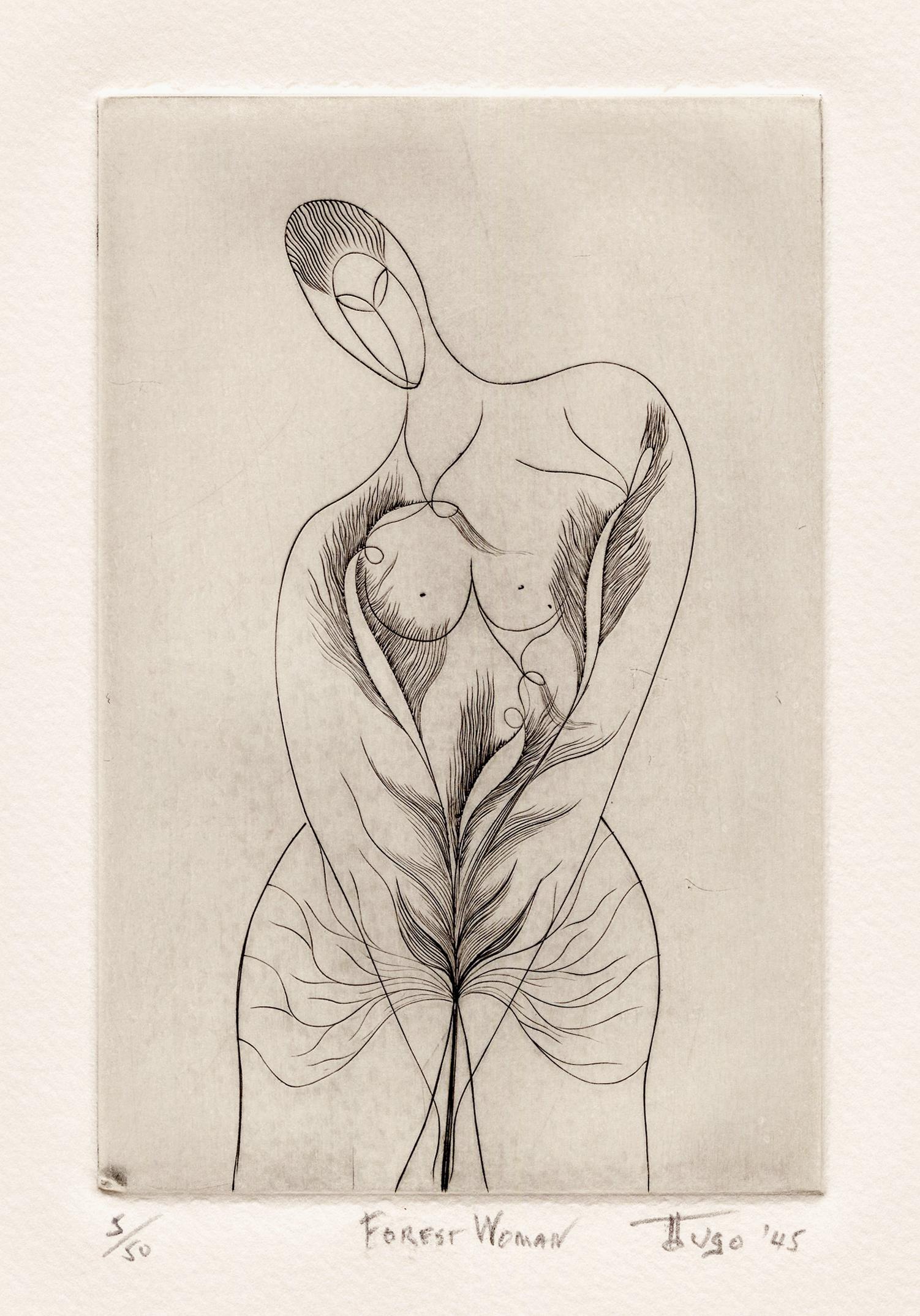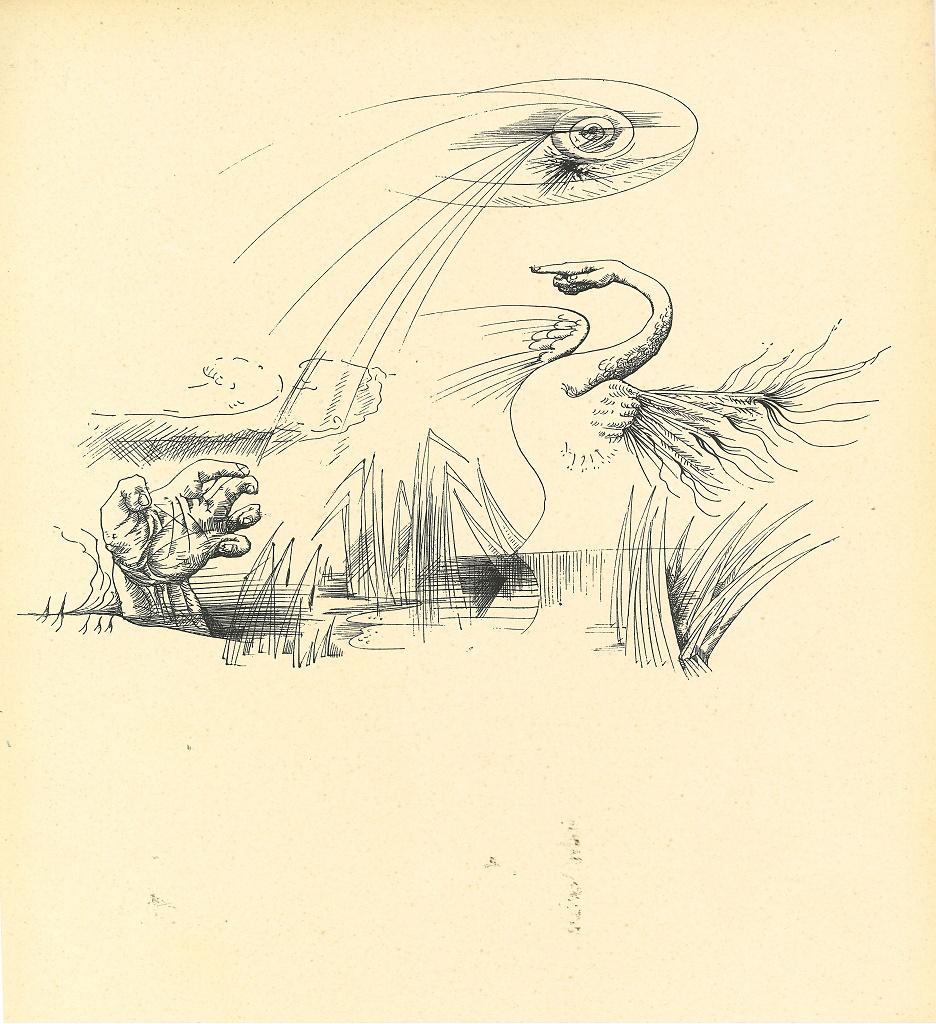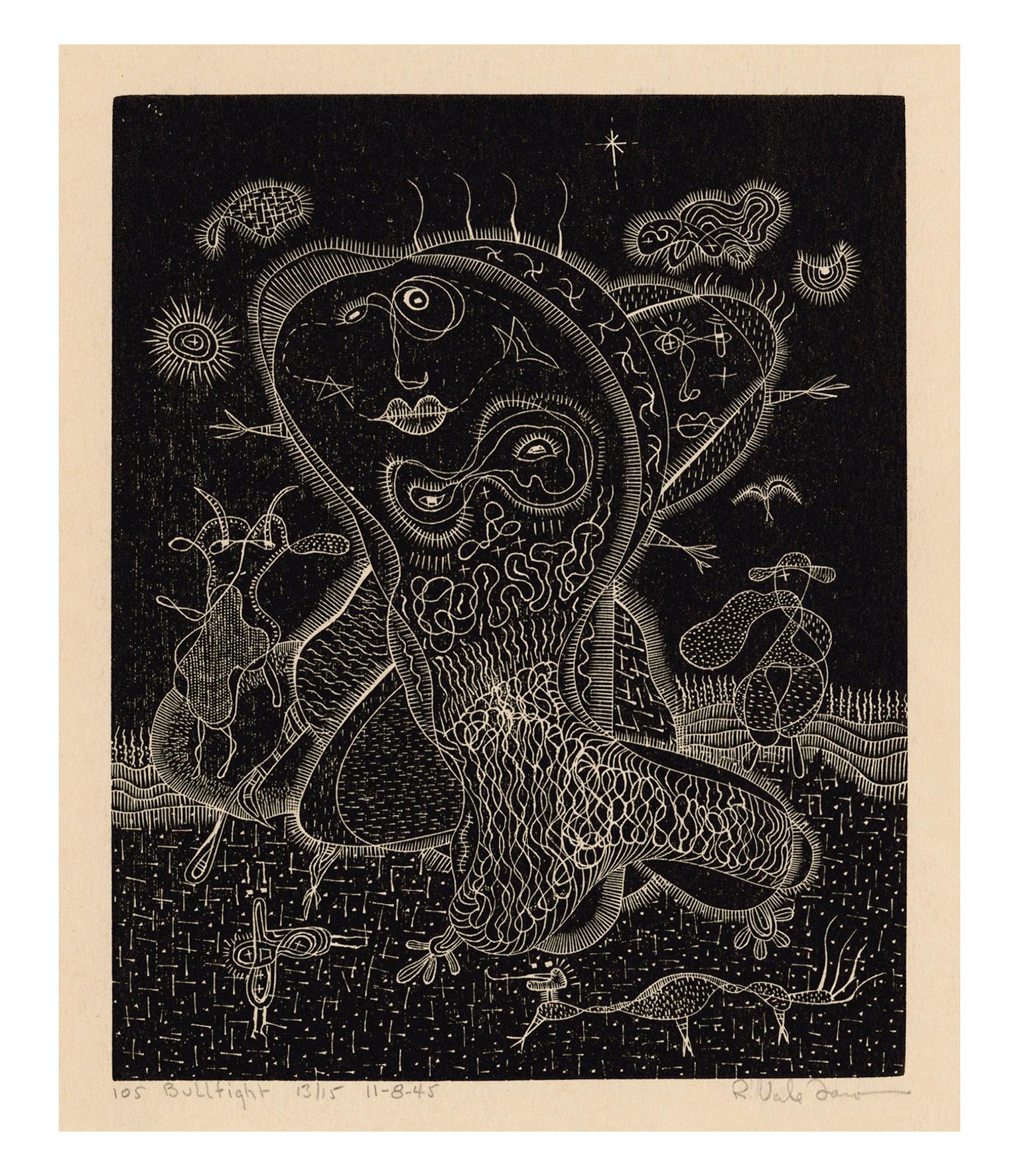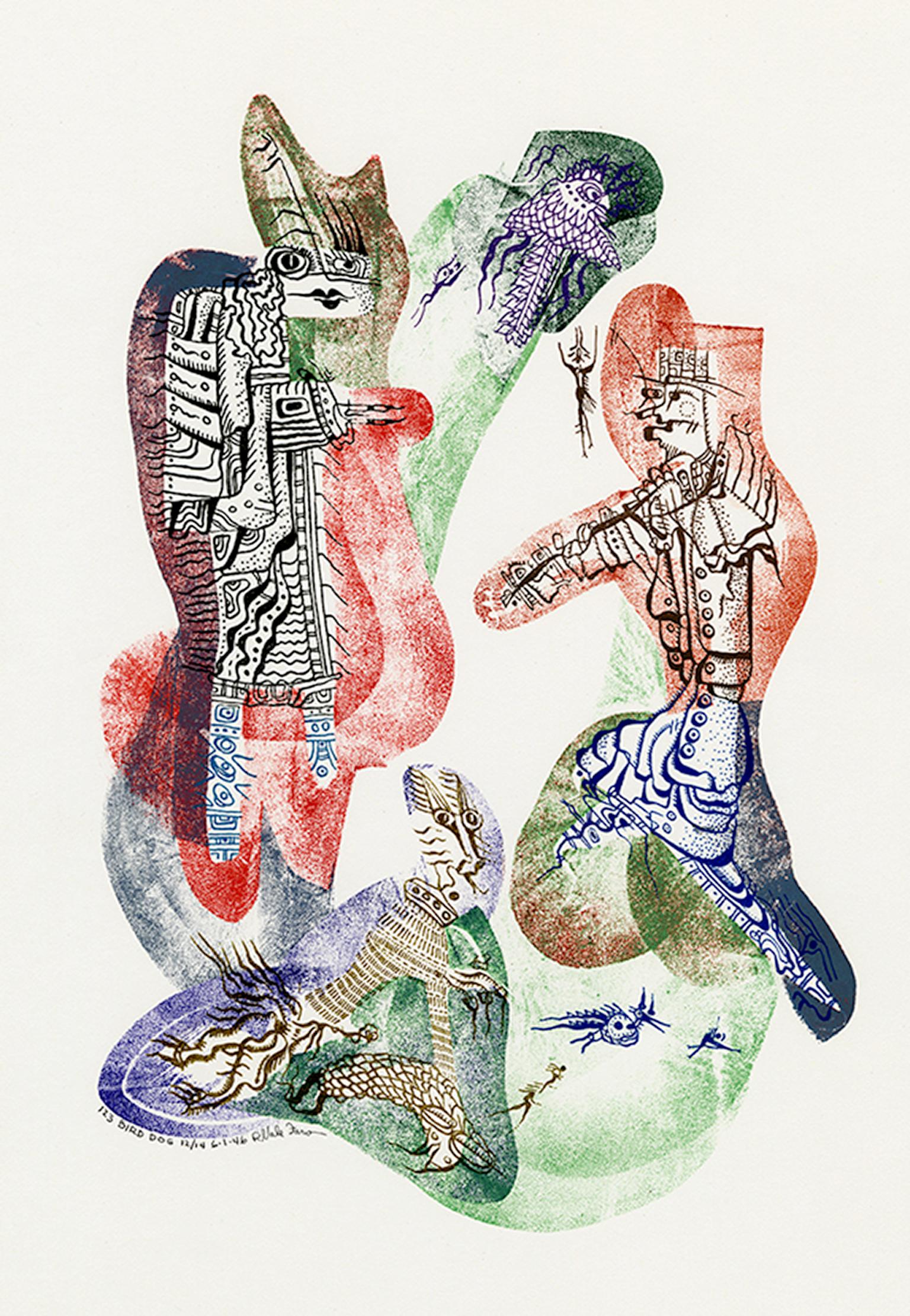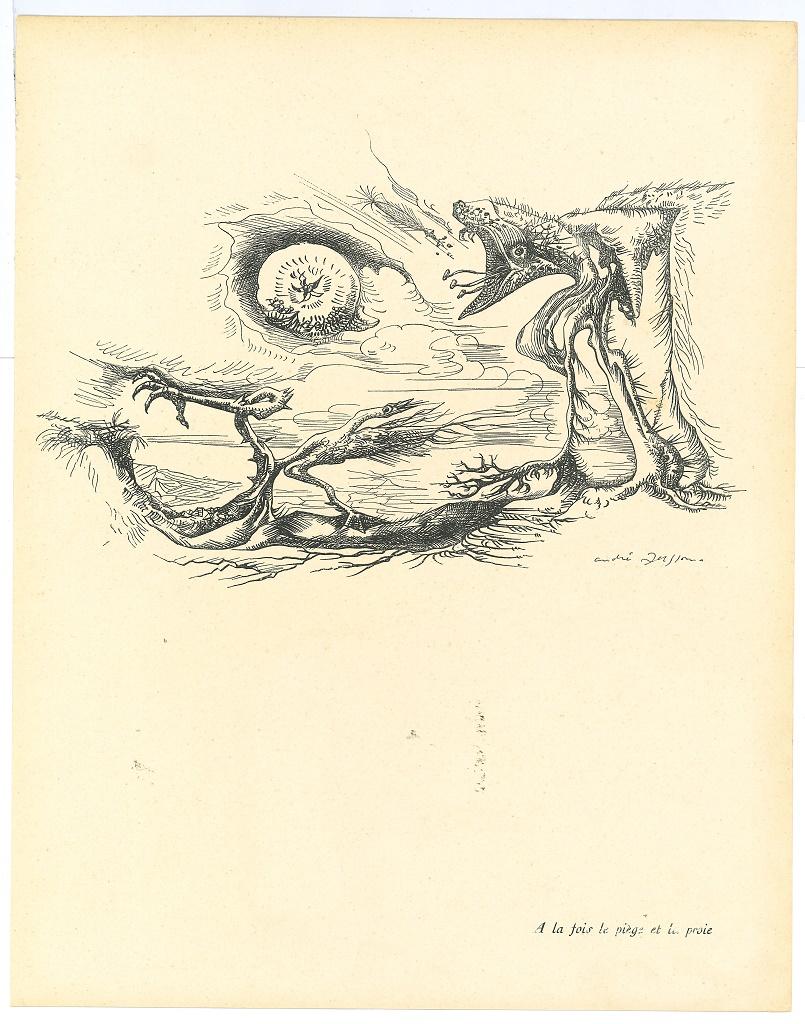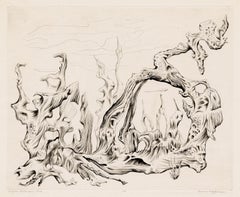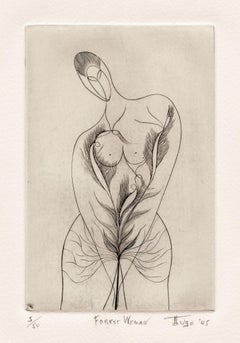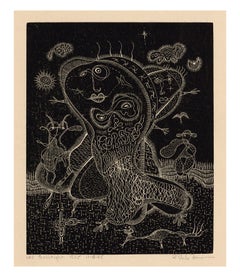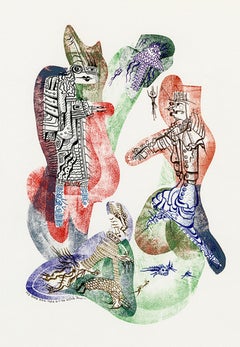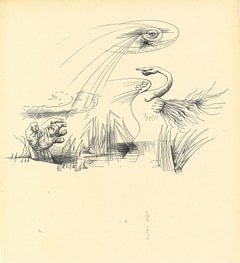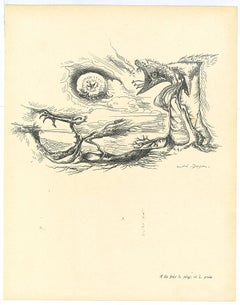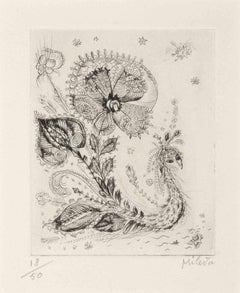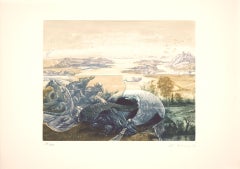Items Similar to 'Early Marshes' — Mid-Century Surrealism, Atelier 17
Want more images or videos?
Request additional images or videos from the seller
1 of 3
Ian Hugo'Early Marshes' — Mid-Century Surrealism, Atelier 171943
1943
$650
£501.66
€571.11
CA$928.14
A$1,012.32
CHF 533.41
MX$12,140.44
NOK 6,716.28
SEK 6,266.15
DKK 4,265.18
About the Item
Ian Hugo, 'Early Marshes', from the portfolio 'Ten Engravings'. engraving, 1943, edition 50. Signed, dated, titled, and numbered '37/50' in pencil. A fine impression, with delicate overall plate tone, on cream wove paper, the full sheet with margins (2 5/8 to 7 inches), in excellent condition.
With the blind stamp 'madeleine-claude jobrack EDITIONS', in the bottom right margin. Matted to museum standards, unframed.
Image size 5 x 5 7/8 inches (127 x 149 mm); sheet size 15 x 11 inches (381 x 279 mm).
Ian Hugo originally created "Ten Engravings" in 1945 and the portfolio included a foreword by his partner and collaborator, Anais Nin. In 1978, Hugo republished the portfolio with Madeleine-Claude Jobrack, an American master printmaker who studied under Stanley William Hayter at Atelier 17, Paris, and with Johnny Friedlaender. When Jobrack returned to the States she managed the Robert Blackburn Printmaking Studio in New York before opening her own printing studio, Madeleine-Claude Jobrak Editions.
“The sign of the true artist is one who creates a complete universe, invents new plants, new animals, new figures to transfer to us a new vision of the universe in which dream and reality fuse. Ian Hugo's plants have eyes, the birds have the delicacy of dragonflies, their feathers have the shape of fans. Humor is apparent in every gesture. He uses a fine spider web to give a feeling of flight, speed, lightness. The body of a woman reveals the structure of a leaf, a plant. Wings are moving in a world unified by mythological themes. This is an animated world, humorous and levitating, elusive and decorative, which by its unique forms and shapes gives us the sensation of a rebirth, a liberation from the usual, the familiar, a visit to a new planet.”
—Anais Nin, from the forward to the portfolio ‘Ten Engravings’
ABOUT THE ARTIST
Ian Hugo was born Hugh Parker Guiler in Boston, Massachusetts, on February 15, 1898. His childhood was spent in Puerto Rico—a "tropical paradise," the memory of which stayed with him and surfaced in both his engravings and his films. He attended school in Scotland and graduated from Columbia University where he studied economics and literature.
Hugo was working with the National City Bank when he met and married author Anais Nin in 1923. The couple moved to Paris the following year, where Nin's diary and Guiler's artistic aspirations flowered. Guiler feared his business associates would not understand his interests in art and music, let alone those of his wife, so he began a second, creative life as Ian Hugo. Ian and Anais moved to New York in 1939. The following year he took up engraving and etching, working at Stanley William Hayter’s experimental printmaking workshop Atelier 17, established at the New School for Social Research.
Hugo began producing surreal images often used to illustrate Nin's books. For Nin, his unwavering love and financial support were indispensable—Hugo was the "fixed center, core... my home, my refuge" (Sept. 16, 1937, Nearer the Moon, The Unexpurgated Diary of Anais Nin, 1937-!939). Fictionalized portraits of Higo and Nin appear in Philip Kaufman's 1990 film drama of a literary love triangle, Henry & June.
Inspired by comments that viewers saw motion in his engravings, Hugo took up filmmaking. He asked the avant-garde filmmaker Sasha Hammid for instruction but was told, "Use the camera yourself, make your own mistakes, make your own style." Hugo embarked on an exploration of the film medium as a vehicle to delve into his dreams, his unconscious, and his memories. Without a specific plan, He would collect resonant images, then reorder or superimpose them, seeking a sense of self-connection through the poetic juxtapositions he created. These intuitive explorations resembled the mystical evocations of his engravings, which he described in 1946 as "hieroglyphs of a language in which our unconscious is trying to convey important, urgent messages."
In the underwater world of his film ‘Bells of Atlantis,’ the light originates from the world above the surface; it is otherworldly, out of place, yet essential. In ‘Jazz of Lights,’ the street lights of Times Square become in Nin's words, "an ephemeral flow of sensations." This flow that she also calls "phantasmagorical" had a crucial impact on Stan Brakhage, who said that without Jazz of Lights (1954), "there would have been no Anticipation of the Night" his autobiographical film which ushered in a new era of experimental modernist filmmaking.
Hugo lived the last two decades of his life in a New York apartment high above street level. In the evenings, surrounded by an electrically illuminated man-made landscape, he dictated his memoirs into a tape recorder and would, from time to time, polish the copper matrices that held the engraved images of his supersensible worlds.
- Creator:Ian Hugo (1900 - 1984, American)
- Creation Year:1943
- Dimensions:Height: 5 in (12.7 cm)Width: 5.88 in (14.94 cm)
- Medium:
- Movement & Style:
- Period:
- Condition:
- Gallery Location:Myrtle Beach, SC
- Reference Number:Seller: 1042211stDibs: LU532312589462
About the Seller
5.0
Recognized Seller
These prestigious sellers are industry leaders and represent the highest echelon for item quality and design.
Platinum Seller
Premium sellers with a 4.7+ rating and 24-hour response times
Established in 1995
1stDibs seller since 2016
333 sales on 1stDibs
Typical response time: 1 hour
Associations
International Fine Print Dealers Association
- ShippingRetrieving quote...Shipping from: Myrtle Beach, SC
- Return Policy
More From This Seller
View All'European Landscape' —Mid-century American Surrealism
By Lawrence Kupferman
Located in Myrtle Beach, SC
Lawrence Kupferman, 'European Landscape', drypoint, edition 50, 1942. Signed, dated, titled, and numbered '7/50' in pencil. A superb, finely nuanced impression, on cream wove paper; the full sheet with margins (1 to 1 3/4 inches); in excellent condition.
Image size 10 7/8 x 13 3/8 inches; sheet size 13 1/8 x 16 1/2 inches. Archivally matted to museum standards, unframed.
An impression of this work is included in the permanent collection of the Syracuse University Art Museum.
ABOUT THE ARTIST
Lawrence Kupferman (1909 - 1982) was born in the Dorchester neighborhood of Boston and grew up in a working-class family. He attended the Boston Latin School and participated in the high school art program at the Museum of Fine Arts, Boston. In the late 1920s, he studied drawing under Philip Leslie Hale at the Museum School—an experience he called 'stultifying and repressive'. In 1932 he transferred to the Massachusetts College of Art, where he first met his wife, the artist Ruth Cobb. He returned briefly to the Museum School in 1946 to study with the influential expressionist German-American painter Karl Zerbe.
Kupferman held various jobs while pursuing his artistic career, including two years as a security guard at the Museum of Fine Arts, Boston. During the 1930s he worked as a drypoint etcher for the Federal Art Project, creating architectural drawings in a formally realistic style—these works are held in the collections of the Fogg Museum and the Smithsonian American Art Museum. In the 1940s he began incorporating more expressionistic forms into his paintings as he became progressively more concerned with abstraction. In 1946 he began spending summers in Provincetown, Massachusetts, where he met and was influenced by Mark Rothko, Hans Hofmann, Jackson Pollock, and other abstract painters. At about the same time he began exhibiting his work at the Boris Mirski Gallery in Boston.
In 1948, Kupferman was at the center of a controversy involving hundreds of Boston-area artists. In February of that year, the Boston Institute of Modern Art issued a manifesto titled 'Modern Art and the American Public' decrying 'the excesses of modern art,' and announced that it was changing its name to the Institute of Contemporary Art (ICA). The poorly conceived statement, intended to distinguish Boston's art scene from that of New York, was widely perceived as an attack on modernism. In protest, Boston artists such as Karl Zerbe, Jack Levine, and David Aronson formed the 'Modern Artists Group' and organized a mass meeting. On March 21, 300 artists, students, and other supporters met at the Old South Meeting House and demanded that the ICA retract its statement. Kupferman chaired the meeting and read this statement to the press:
“The recent manifesto of the Institute is a fatuous declaration which misinforms and misleads the public concerning the integrity and intention of the modern artist. By arrogating to itself the privilege of telling the artists what art should be, the Institute runs counter to the original purposes of this organization whose function was to encourage and to assimilate contemporary innovation.”
The other speakers were Karl Knaths...
Category
1940s Surrealist Abstract Prints
Materials
Drypoint
'Forest Woman' — Mid-Century Surrealism, Atelier 17
Located in Myrtle Beach, SC
Ian Hugo, 'Forest Woman', engraving, 1945, edition 50. Signed, dated, titled, and numbered '5/50' in pencil. With the blind stamp 'madeleine-claude jobrack E...
Category
1940s Surrealist Figurative Prints
Materials
Engraving
'Bullfight'— Mid-century American Surrealism
By Robert Vale Faro
Located in Myrtle Beach, SC
Robert Vale Faro, 'Bullfight', wood engraving, 1945, edition 15. Signed, dated, titled, and numbered '105' (the artist's inventory number) and '13/15' in pencil. A fine, richly-inked impression, on cream wove paper, with full margins (1 1/16 to 2 3/8 inches), in excellent condition. Scarce. Matted to museum standards, unframed.
Image size 5 1/16 x 4 1/16 inches (129 x 103 mm); sheet size 8 9/16 x 6 5/16 inches (217 x 160 mm).
An impression of this work is included in the museum collection of the National Gallery of Art.
ABOUT THE ARTIST
Robert Vale Faro (1902-1988) was a well-known modernist architect and artist associated with the Chicago Bauhaus. He received his degree in architecture and design from the Armour Institute in Chicago and worked at L'Ecole des Beaux-Arts, Paris, from 1924-27, where he was influenced by Harry Kurt Bieg and Le Corbusier. Upon his return to Chicago, Faro worked with the important modernist Chicago architects George and William Keck under Louis Sullivan.
Faro founded the avant-garde printmaking group Vanguard in 1945. The group counted Atelier 17 artists Stanley William Hayter, Sue Fuller, and Anne Ryan as New York members and Francine Felsenthal...
Category
1940s Surrealist Abstract Prints
Materials
Woodcut
$360 Sale Price
20% Off
'Bird Dog' — Mid-century American Surrealism
By Robert Vale Faro
Located in Myrtle Beach, SC
Robert Vale Faro, 'Bird Dog', color lithograph with relief collagraph, 1946, edition 14. Signed, dated, titled, and numbered '123' (the artist's inventory number) and '12/14' in pen. A fine impression, with fresh colors, on heavy, cream, wove paper; the full sheet with margins(1 3/4 to 3 1/2 inches), in excellent condition. Scarce. Matted to museum standards, unframed.
Image size 10 1/8 x 6 7/8 inches (257 x 174 mm); sheet size 17 x 11 7/16 inches (432 x 291 mm).
A collagraph is a relief print made from a collage of various materials adhered to a metal, plastic, hardboard, or other type of ground plate. In this work, the artist appears to have combined a lithograph with a collagraph to achieve the intricately textured image.
ABOUT THE ARTIST
Robert Vale Faro (1902-1988) was a well-known modernist architect and artist associated with the Chicago Bauhaus. He received his degree in architecture and design from the Armour Institute in Chicago and worked at L'Ecole des Beaux-Arts, Paris, from 1924-27, where he was influenced by Harry Kurt Bieg and Le Corbusier. Upon his return to Chicago, Faro worked with the important modernist Chicago architects George and William Keck under Louis Sullivan.
Faro founded the avant-garde printmaking group Vanguard in 1945. The group counted Atelier 17 artists Stanley William Hayter, Sue Fuller, and Anne Ryan as New York members and Francine Felsenthal of Chicago. The Brooklyn Museum mounted a show of Vanguard artists' work in 1946, which subsequently toured several other institutions in the United States.
Faro's visionary graphics from the 1940s are a sophisticated blend of Abstract Expressionism, Surrealism, and Indian Space...
Category
1940s Surrealist Abstract Prints
Materials
Lithograph
$600 Sale Price
20% Off
'Salient in February' — Mid 20th-Century Surrealism
By Edward August Landon
Located in Myrtle Beach, SC
Edward Landon 'Salient in February', color serigraph, 1945, edition 40, Ryan 166. Signed in pencil. Titled, dated, and annotated 'ED. 40' in pencil. A fine impression, with fresh col...
Category
Mid-20th Century Surrealist Abstract Prints
Materials
Screen
'Encircled' — Mid-Century Surrealism, Atelier 17
Located in Myrtle Beach, SC
Ian Hugo, 'Encircled', engraving, 1946, edition 50. Signed, dated, titled, and numbered '5/50' in pencil. With the blind stamp 'madeleine-claude jobrack EDIT...
Category
1940s Surrealist Figurative Prints
Materials
Engraving
You May Also Like
Surrealist Composition 8 - Original Collotype after A. Masson - Mid-20th Century
By André Masson
Located in Roma, IT
Surrealist Composition 8 is an original collotype realized after André Masson in the Mid-20th.
The artwork is in good conditions, no signature on a yellowed paper.
André Masson (18...
Category
Mid-20th Century Surrealist More Prints
Materials
Black and White
Surrealist Composition 7 - Original Collotype after A. Masson - Mid-20th Century
By André Masson
Located in Roma, IT
Surrealist Composition 7 is an original collotype realized after André Masson in the mid-20th Century.
The artwork is in good conditions, no signature, on a yellowed paper.
André M...
Category
Mid-20th Century Surrealist Abstract Prints
Materials
Black and White
Surreal Composition - Etching - mid-20th Century
Located in Roma, IT
Surreal Composition is an original Etching realized in the mid-20th Century Attibuted to Mileva Roller.
Good Conditions.
Numbered. Edition, 18/50.
The...
Category
Early 20th Century Modern Figurative Prints
Materials
Pencil
Eduardo Naranjo Spanish Artist Original Hand Signed engraving 1984 n2
Located in Miami, FL
Eduardo Naranjo (Spain, 1944)
'Creación V', 1984
engraving on paper
15 x 20.9 in. (38 x 53 cm.)
Edition of 225
ID: NAR1115-002-225
Hand-signed by author
Category
1980s Surrealist Prints and Multiples
Materials
Paper, Engraving, Screen
Composition, Variations sur l'imaginaire, Fred Deux
By Fred Deux
Located in Southampton, NY
Lithograph on vélin de Rives paper. Inscription: hand signed and unnumbered, as issued. Good condition. Notes: From the folio, Variations sur l'imaginaire, 1972. Published by Philipp...
Category
1970s Surrealist Landscape Prints
Materials
Lithograph
$796 Sale Price
20% Off
Free Shipping
Composition, Variations sur l'imaginaire, Enrico Baj
By Enrico Baj
Located in Southampton, NY
Lithograph on vélin de Rives paper. Inscription: hand signed and unnumbered, as issued. Good condition. Notes: From the folio, Variations sur l'imaginaire, 1972. Published by Philipp...
Category
1970s Surrealist Landscape Prints
Materials
Lithograph
$796 Sale Price
20% Off
Free Shipping
More Ways To Browse
Vintage Atlantis
Atelier Hugo
Ian Hugo
Keith Haring Skate
Leon Gaucherel
Marc Chagall Paradise
Maria Izquierdo
Nicolas Cochin
Original Etching 16th Century
Paloma Picasso Print
Paris Gallery Poster
Picasso 1966
Picasso Bottle
Picasso Color Lithograph
Picasso Horse Art
Picasso Toro Y Toreros 1959
Pierre Auguste Renoir Le Chapeau Epingle
Pope Innocent
